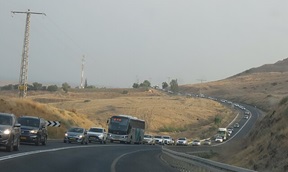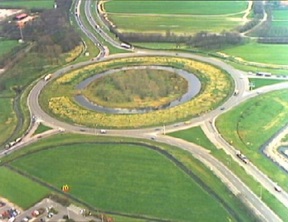The site change.inc contained an interesting article (in Dutch) on energy hubs – a central place where regional companies and households share their energy production and consumption. In the Netherlands, 1,200 of such hubs could play a major role in preventing grid congestion and CO2 emissions.

Electricity grid under pressure
The Dutch electricity grid is coming under increased pressure. In 2022, peak demand was 17.5 GW, whereas installed solar capacity already amounted to more than 19 GW. Actual installed wind capacity is 8.8 GW already, and this will rise to more than 50 GW in 2050. Energy hubs would partly be able to solve the problems arising from this situation. Together, they could reduce the electricity peak load by 3.2 GW; and also reduce CO2 emissions by 1.5 to 4.8 Mton yearly (on a Dutch total of 158 Mton). As documentation (links in Dutch) by Royal HaskoningDHV shows.
In an energy hub, all energy production and consumption in a certain area will be tuned to each other. Residual heat produced by companies can be used to heat homes or offices. Companies and residual areas can be connected to solar and wind parks; or alternatively, to rooftop solar panels. We can use any surplus electricity to produce hydrogen; or store it in a battery. We can use this to power electric buses and vans. We can use electric cars is a residential area as a battery, for peak shaving purposes.
Cooperation
Within a hub, companies will be able to use a single electric outlet or contract together. They can sell any excess electricity to their neighbours; they can tune their electricity demand to each other, in order to prevent peaks in supply and demand. This will require however that all those points of electricity supply and demand will be controlled by smart algorithms, in order to arrive at a fine-tuning of the local grid.
Therefore, companies will have to cooperate, also with residents, housing companies and municipalities. In the case of companies, park management or employer’s associations may take the initiative; in the case of residential areas, this role may be taken up by housing corporations or municipalities. Moreover, energy hubs will help to solve the problem of grid congestion, and bring about that companies on waiting lists will get a connection to the grid.

The energy hub
This can indeed be done if the energy hub would lower maximum peak charge. This maximum is required very rarely, but the size of the grid connection will be tuned to it. By lowering peak charges, lighter grid connections will be possible, and this will ease the burden on the overcharged grid.
In the Netherlands, there are a number of energy hubs already; for instance overseen by an energy cooperative or collective. Schiphol Trade Park is one of them; there, companies share a connection, and they exchange electricity. In Amsterdam harbour, congestion problems are being solved by clever distribution of available power. In Heerhugowaard, any excess heat or cold is being distributed among companies, institutions and residences; everyone shares the same subsurface infrastructure of heat and cold – through a collective subscription. That reduces investment costs; it is even beneficial to participants, and reduces CO2 emissions.
Twelve hubs in one region
In the Drechtsteden region of the province of South Holland, as many as twelve regional energy hubs have been founded. Companies participating in the scheme are allowed to supply each other with electricity, something they would not be able to do if they acted on their own. On peak moments, they can use more electricity because they are allowed to use the neighbour’s connection. Moreover, together they can invest in a battery, in which they store any excess electricity from solar panels or wind turbines; or construct a common loading dock for electric trucks. Encouraged to do so by congestion problems that could otherwise arise.
At two major industrial estates in Dordrecht, something else plays a role. Industrial estate Distripark mainly houses major distribution centres, with tens of thousands of solar panels on their roofs. On sunny days, these produce too much electricity. Then, companies that feed their electricity into the grid will have to turn down their equipment. On neighbouring Dordtse Kil 3, around the corner, new companies cannot be connected to the grid, and existing companies receive too little electricity. Which will even be more the case in the future, as they will want to charge their electric vans. But when they form a new corporation, they will be able to use 79% of all self-produced electricity themselves, particularly for driving electrically.
The problem of grid congestion keeps on growing
In the Netherlands, the problem of grid congestion keeps on growing. The Dutch grid is overburdened already. Check the red coloured areas on maps of the website of the Dutch grid management company. In three quarters of the country, new connections have become impossible. There are two kinds of congestion: production congestion and distribution congestion. In the case of production congestion, on very sunny and windy moments the production of green electricity is larger than the grid can carry. Therefore, in the summer, wind and solar parks are often being switched off. In July 2024, 11% of all sustainable electricity produced in the Netherlands got lost. This is also an issue for wind parks at sea. Their construction may stagnate, if they will not be able to deliver electricity to their customers in case of grid congestion.
Distribution congestion is another problem. Here, businesses and consumers demand more electricity than the grid can deliver. This is a year-around problem. Even at present, some companies cannot be connected to the grid; this also holds true for some solar parks in meadows and on rooftops. Waiting lists keep on growing. Energy hubs will be able to solve at least part of the problems involved.
Interesting? Then also read:
The overcrowded electricity grid
Local network required against grid congestion
Local grid optimization
